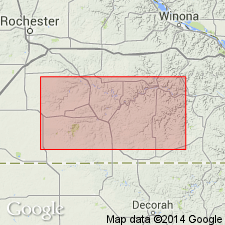
- Usage in publication:
-
- Cummingsville member
- Modifications:
-
- Original reference
- Dominant lithology:
-
- Limestone
- AAPG geologic province:
-
- Iowa shelf
Summary:
Pg. 764-766; and 1957, GSA Bull., v. 68, no. 8, p. 1036. Cummingsville member (of Galena formation). Proposed for interbedded limestones and shaly limestones at base of Galena formation that were formerly included in Prosser member. Unit is argillaceous limestone, yellowish-gray to pale-yellowish-brown, generally microgranular, and thin and crinkly bedded, with conspicuous to thick shaly partings. Thin beds are typically grouped into massive units that are separated by smoother more prominent shaly partings. Thickness at type locality 63 feet; essentially uniform throughout its extent. Overlies Decorah formation; base is the level at which the green shales of the Decorah are succeeded by rock that is predominantly limestone, usually beds of lumpy of nodular limestone in a shale matrix. Recognized in southeastern Minnesota and northwestern Iowa. Age is Middle Ordovician.
Type section: 0.5 mi north of Cummingsville, on east edge of SE/4 sec. 21, T. 105 N., R. 12 W. Name derived from hamlet of Cummingsville, Olmsted Co., MN, on State Hwy 30, 3.5 mi west of Chatfield, MN.
Source: US geologic names lexicon (USGS Bull. 1200, p. 1007-1008).
For more information, please contact Nancy Stamm, Geologic Names Committee Secretary.
Asterisk (*) indicates published by U.S. Geological Survey authors.
"No current usage" (†) implies that a name has been abandoned or has fallen into disuse. Former usage and, if known, replacement name given in parentheses ( ).
Slash (/) indicates name conflicts with nomenclatural guidelines (CSN, 1933; ACSN, 1961, 1970; NACSN, 1983, 2005, 2021). May be explained within brackets ([ ]).

